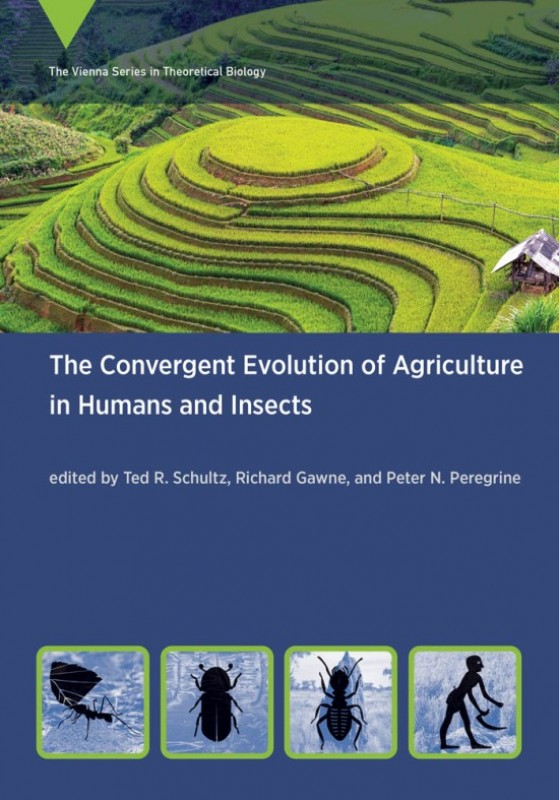News Details

A new open access book in the MIT Press Vienna Series in Theoretical Biology- "The Convergent Evolution of Agriculture in Humans and Insects" - explores common elements in the evolutionary histories of both human and insect agriculture resulting from convergent evolution.
Edited by Ted R. Schultz, Richard Gawne and Peter N. Peregrine, contributors include Duur K. Aanen, Niels P. R. Anten, Peter H. W. Biedermann, Jacobus J. Boomsma, Laura T. Buck, Guillaume Chomicki, Tim Denham, R. Ford Denison, Dorian Q. Fuller, Richard Gawne, Nicole M. Gerardo, Thomas C. Harrington, Ana Ješovnik, Judith Korb, Chase G. Mayers, George R. McGhee, Kenneth Z. McKenna, Lumila P. Menéndez, Peter N. Peregrine, Ted R. Schultz.
We interviewed Richard and Ted to gain some "behind the scenes" insights on the 38th Altenberg workshop (2019) that led to the publication of this volume.
Q: What was the motivation for putting together the workshop? What kinds of issues did you address?
We wanted to convene researchers who rarely talk to each other due to the way academic research is compartmentalized. Research on the evolution of agriculture tends to be highly specialized, with little collaboration between scientists working in different fields and study systems. The goal of this workshop was to take some preliminary steps toward changing this. The workshop addressed the evolution of agriculture from a truly interdisciplinary perspective. Researchers on human and insect agriculture were able to interact extensively, often for the first time, in order to understand the mechanisms and consequences of agricultural food production in human and non-human systems. Specifically, we convened biologists (including entomologists), anthropologists, and archaeologists who work on human and non-human agriculture. Issues addressed included sociobiological forces that might either favor or disfavor agriculture, commonalities shared by human and non-human agriculturalists, the details of various non-human agricultural systems, parasitoids of human and non-human agriculture, pathways to crop domestication in human agriculture, phenotypic change in humans as a result of agriculture, and developmental mechanisms underlying domestication traits.

Q: What was the workshop like? Do you have any interesting conversations or highlights you'd like to share from the workshop?
The workshop led to many interesting discussions, and important disagreements were highlighted. Part of the benefit of a workshop such as ours is that it enables participants to develop broad-brush comparative hypotheses, and immediately get feedback on their viability from experts in other areas. Overall, there was a spirit of collaboration, and an intense interest in learning more about relevant research being conducted on the diverse study systems represented at the meeting. The workshop was intellectually stimulating and fun. Everyone got along well and fully explored the workshop theme.
Q: How did you structure the book? How are the chapters tied together?
The book is structured topically, rather than taxonomically. There are many different perspectives from which one might study the evolution of agriculture, and we attempted to use the approaches of the authors to guide the organization of the book. The chapters have strong conceptual ties to one another, and we would like to think that many of these were forged through interactions that occurred at the Altenberg Workshop. We gave authors the freedom to choose what to write about, only asking them to address the subject of the book somewhere in their chapters.
The chapters rather naturally sorted into four main themes: (i) comparative analyses of human and nonhuman agriculture (two chapters); (ii) conflict and cooperation in human and nonhuman agriculture (three chapters); (iii) the diversity of insect agriculture (four chapters); and (iv) patterns of convergence in agriculturalists, domesticates, and parasites (five chapters). Some of the chapters are focused fairly narrowly and only briefly address the theme of the book (and of the workshop), whereas others are centered around the theme of comparing human and nonhuman agriculture. In spite of this difference in focus across chapters, it is our hope that assembling all of the chapters in one volume has the net effect of providing a broader context in which a reader who reads all the chapters will make connections across the fields and subfields of human and nonhuman agricultural evolution.
Q: Did anything else come out of the workshop? Do you have future plans to follow up with another event or collection?
This workshop aimed to forge theoretical foundations for a new field of research in comparative studies of the evolution of agriculture. The connections made between researchers will, we hope, continue well into the future, and the book will serve as a foundation for the next generation of researchers who are drawn to this emerging area of research. We want the book to represent tangible evidence of a new, interdisciplinary field of cross-species agricultural studies. That the book is already serving this purpose is demonstrated by a review in Science (J.D. Postido and J.E. Strassman, 21 April 2022; Science 376: 359; DOI: 10.1126/science.abq2570) and by multiple requests for interviews on the subject of nonhuman agriculture, including:
Handwer, Brian. "Could Ants, Termites and Fishes Make Humans Better Farmers?" Smithsonian Magazine (online): At the Smithsonian. 17 May 2022.
Wu, Katherine J. "Do Gophers . . . Farm?" 11 July 2022. The Atlantic.
Thank you, Richad and Ted, and congratulations on the media attention!
The book is available as an open access publication. You can download individual chapters from the MIT site: https://direct.mit.edu/books/oa-edited-volume/5272/The-Convergent-Evolution-of-Agriculture-in-Humans.

